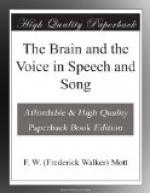In considering the relation of the Brain to the Voice we have not only a physiological but a psychological problem to deal with. Since language is essentially a human attribute, we can only study the relation of the Brain to Speech by observations on human beings who during life have suffered from various speech defects, and then correlate these defects with the anatomical changes found in the brain after death.
Between the vocal instrument of the primitive savage and that of the most cultured singer or orator there is little or no discoverable difference; neither by careful naked-eye inspection of the brain, nor aided by the highest powers of the microscope, should we be able to discover any sufficient structural difference to account for the great difference in the powers of performance of the vocal instrument of the one as compared with that of the other; nor is there any sufficient difference in size or minute structure of the brain to account for the vast store of intellectual experiences and knowledge of the one as compared with the other. The cultured being descended from cultured beings inherits tendencies whereby particular modes of motion or vibration which have been experienced by ancestors are more readily aroused in the central nervous system; when similar stimuli producing similar modes of motion affect the sense organs. But suppose there were an island inhabited only by deaf mutes, upon which a ship was wrecked, and the sole survivors of the wreck were infants who had never used the voice except for crying, would these infants acquire articulate speech and musical vocalisation? I should answer, No. They would only be able to imitate the deaf mutes in their gesture language and possibly the musical sounds of birds; for the language a child learns is that which it hears; they might however develop a simple natural language to express their emotions by vocal sounds. The child of English-speaking parents would not be able spontaneously to utter English words if born in a foreign country and left soon after birth amongst people who could not speak a word of English, although it would possess a potential facility to speak the language of its ancestors and race.
It is necessary, however, before proceeding further, to say a few words explanatory of the brain and its structure, and the reader is referred to figs. 15, 16, 17. The brain consists of (1) the great brain or cerebrum, (2) the small brain or cerebellum, and (3) the stem of the brain, which is continuous with the spinal cord. The cerebro-spinal axis consists of grey matter and white matter. The grey matter covers the surface of the cerebrum and cerebellum, the white matter being internal. The stem of the brain, the medulla oblongata, and the spinal cord, consists externally of white matter, the grey matter being internal. The grey matter consists for the most part of nerve cells (ganglion cells), and the white matter consists of nerve fibres; it is white




